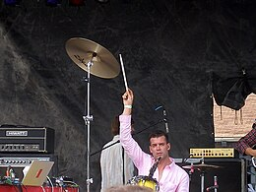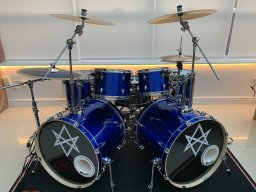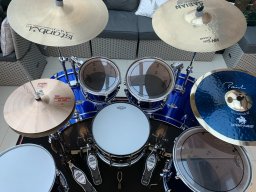flamateurhour
Active Member
High vs. Low cymbals. This subject has been discussed ad nauseam. Seeing as how I don't know how to ride a horse, I figured I'd beat a dead one instead and hopefully provide at least something new to the discussion. I believe that there are a handful of benefits to this setup (if done correctly), and I'll cover them below. They are: efficient use of space, ergonomics (resulting in decreased arm strain), and posture.
To start, I'm just going to clarify that when I refer to this high cymbal placement, I'm referring to a height where the wingnut is roughly at chin level - with adjustments for personal needs - and the cymbal is sloped downwards towards the player. The tilt of the cymbal is largely dictated by the degree of elbow flexion with the elbows hanging loosely at the player's side, with the plane of the bow almost parallel to that of the drumstick when held with a neutral wrist. I personally increase the tilt ever so slightly so that I'm not accidentally doing crashes. To emphasize, the core of this setup centers around relaxed shoulders and upper arms.
Efficient Use of Space
This relaxation is achieved by the ergonomics of the setup, which is a direct result of the space efficiency. Cymbal stands have three primary placement variables in this discussion: height, tilt, and proximity. In this case, I will specifically be looking at the distance of the cymbal stand from the player themselves. These three variables have an inherent relationship when setting up cymbals, of which the most frequently discussed is height vs. tilt. The higher the cymbal, the more it has to be tilted in order for the player to easily access the bow/bell easily. The introduction of proximity into this makes things interesting. Simply put, cymbals take up space, and the closer a cymbal gets to the player, the more of their drums (usually floor tom/2nd rack tom) will be covered up. This is where cymbal tilt comes into play. From a bird's eye view, the more a cymbal tilts, the less space its profile will take up (the profile shape essentially shifts from a circle to an oval), allowing the player to bring the cymbal closer to themselves without covering up their toms. However, tilting a cymbal makes it take up more space on the vertical axis. If you run low cymbals and try to tilt it, your edges will bump against your drums, and it will be nearly impossible to crash. So, the solution? Raise those puppies up.
Ergonomics/Biomechanics
The weight of the hand, drumstick, and part of the forearm itself all contribute to what is called the 'load'. Taken together, this is a force that the muscles have to counteract to either keep the arm still or move it according to the drummer's needs. This force is exerted at the end of the lever, which in this case is your wrist where you hold (and play) the stick. When your forearm is more horizontal (as when hitting lower-placed cymbals), the load force has a longer lever arm - that is, the distance between the load (at the wrist) and the fulcrum (at the elbow). Therefore, more effort must be applied by the muscles to either hold up the arm against gravity or move it. This is why carrying a heavy object feels easier when it's held close to your body, and harder when it's held further away: increasing the length of the lever arm increases the leverage force and the effort required to counteract it. By contrast, when the forearm is in a more vertical position (as when hitting higher-placed cymbals), the lever arm associated with the load force is shorter. This results in less leverage force applied to the elbow joint and less muscular effort is required to maintain or move the arm. The load becomes primarily vertical - directly along the radius and ulna bones - and the forearm muscles have fewer forces to counteract.
So it's not so much that the weight of the hand, stick, and forearm increase the leverage force, but that their weight becomes more influential in a horizontal position due to the increase in the lever arm. In a vertical position the same weights have less leverage, so less muscular effort is required to counteract their force. This can make drumming feel less strenuous and enable more endurance over long playing periods.
Posture
The benefit of the cymbal height and tilt adjustment to posture arises from the intersection of both ergonomics and efficient use of space. Ergonomically, adjusting the cymbals to a higher position encourages the drummer to sit upright, aligning the spine more naturally and effectively. This upright posture is acknowledged to be beneficial in preventing back discomfort and musculoskeletal problems in the long-term. It helps to maintain the natural curvature of the spine, which also allows the shoulder blades to rest in a more relaxed, "down and back" position, potentially reducing the risk of shoulder strain or injury. Additionally, the efficient use of space that the higher and steeply-tilted cymbal placement provides can contribute to posture benefits as well. By placing the cymbal stand closer due to its tilt, the drummer can easily reach the cymbals without straining or stretching uncomfortably. This comfortable reach can reduce overall tension in the drummer's body, which also encourages a more relaxed and effective posture. Overall, the intersect of ergonomics and space efficiency in higher cymbal placement encourages a natural, comfortable, and safe playing posture, which can contribute to improved performance, stamina, and injury prevention in drummers.
--
In the end, I am a big proponent of "doing what feels right", and if low is your move and what you've built your muscle memory around, it makes total sense to do. But, just wanted to make my case.
To start, I'm just going to clarify that when I refer to this high cymbal placement, I'm referring to a height where the wingnut is roughly at chin level - with adjustments for personal needs - and the cymbal is sloped downwards towards the player. The tilt of the cymbal is largely dictated by the degree of elbow flexion with the elbows hanging loosely at the player's side, with the plane of the bow almost parallel to that of the drumstick when held with a neutral wrist. I personally increase the tilt ever so slightly so that I'm not accidentally doing crashes. To emphasize, the core of this setup centers around relaxed shoulders and upper arms.
Efficient Use of Space
This relaxation is achieved by the ergonomics of the setup, which is a direct result of the space efficiency. Cymbal stands have three primary placement variables in this discussion: height, tilt, and proximity. In this case, I will specifically be looking at the distance of the cymbal stand from the player themselves. These three variables have an inherent relationship when setting up cymbals, of which the most frequently discussed is height vs. tilt. The higher the cymbal, the more it has to be tilted in order for the player to easily access the bow/bell easily. The introduction of proximity into this makes things interesting. Simply put, cymbals take up space, and the closer a cymbal gets to the player, the more of their drums (usually floor tom/2nd rack tom) will be covered up. This is where cymbal tilt comes into play. From a bird's eye view, the more a cymbal tilts, the less space its profile will take up (the profile shape essentially shifts from a circle to an oval), allowing the player to bring the cymbal closer to themselves without covering up their toms. However, tilting a cymbal makes it take up more space on the vertical axis. If you run low cymbals and try to tilt it, your edges will bump against your drums, and it will be nearly impossible to crash. So, the solution? Raise those puppies up.
Ergonomics/Biomechanics
The weight of the hand, drumstick, and part of the forearm itself all contribute to what is called the 'load'. Taken together, this is a force that the muscles have to counteract to either keep the arm still or move it according to the drummer's needs. This force is exerted at the end of the lever, which in this case is your wrist where you hold (and play) the stick. When your forearm is more horizontal (as when hitting lower-placed cymbals), the load force has a longer lever arm - that is, the distance between the load (at the wrist) and the fulcrum (at the elbow). Therefore, more effort must be applied by the muscles to either hold up the arm against gravity or move it. This is why carrying a heavy object feels easier when it's held close to your body, and harder when it's held further away: increasing the length of the lever arm increases the leverage force and the effort required to counteract it. By contrast, when the forearm is in a more vertical position (as when hitting higher-placed cymbals), the lever arm associated with the load force is shorter. This results in less leverage force applied to the elbow joint and less muscular effort is required to maintain or move the arm. The load becomes primarily vertical - directly along the radius and ulna bones - and the forearm muscles have fewer forces to counteract.
So it's not so much that the weight of the hand, stick, and forearm increase the leverage force, but that their weight becomes more influential in a horizontal position due to the increase in the lever arm. In a vertical position the same weights have less leverage, so less muscular effort is required to counteract their force. This can make drumming feel less strenuous and enable more endurance over long playing periods.
Posture
The benefit of the cymbal height and tilt adjustment to posture arises from the intersection of both ergonomics and efficient use of space. Ergonomically, adjusting the cymbals to a higher position encourages the drummer to sit upright, aligning the spine more naturally and effectively. This upright posture is acknowledged to be beneficial in preventing back discomfort and musculoskeletal problems in the long-term. It helps to maintain the natural curvature of the spine, which also allows the shoulder blades to rest in a more relaxed, "down and back" position, potentially reducing the risk of shoulder strain or injury. Additionally, the efficient use of space that the higher and steeply-tilted cymbal placement provides can contribute to posture benefits as well. By placing the cymbal stand closer due to its tilt, the drummer can easily reach the cymbals without straining or stretching uncomfortably. This comfortable reach can reduce overall tension in the drummer's body, which also encourages a more relaxed and effective posture. Overall, the intersect of ergonomics and space efficiency in higher cymbal placement encourages a natural, comfortable, and safe playing posture, which can contribute to improved performance, stamina, and injury prevention in drummers.
--
In the end, I am a big proponent of "doing what feels right", and if low is your move and what you've built your muscle memory around, it makes total sense to do. But, just wanted to make my case.





